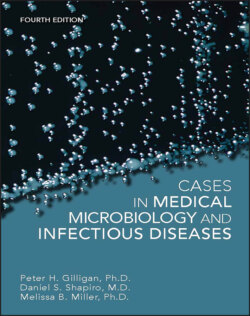Читать книгу Cases in Medical Microbiology and Infectious Diseases - Melissa B. Miller - Страница 24
Infectious disease diagnosis from peripheral blood smears and tissue sections
ОглавлениеNot all staining used in the diagnosis of infectious disease is done in the microbiology laboratory. The hematologist and the anatomical pathologist can play important roles in the diagnosis of certain infectious diseases.
The peripheral blood smear is the method of choice for detection of one of the most important infectious diseases in the world, malaria, which is caused by protozoans within the genus Plasmodium. The various developmental stages of these parasites are detected in red blood cells. Other, less frequently encountered parasites seen in a peripheral blood smear include Babesia species, trypanosomes, and the microfilariae.
Bacterial and fungal pathogens may be seen in peripheral smears on occasion. The most likely of these is Histoplasma capsulatum, which is seen as small, intracellular yeasts in peripheral white blood cells. Ehrlichia and Anaplasma can produce characteristic inclusions (morulae), which can be seen in peripheral mononuclear cells and granulocytic cells, respectively.
Examination of tissue by the anatomical pathologist is an important technique for detecting certain infectious agents. Tissue cysts due to toxoplasmosis can be detected in brain biopsy material from patients with encephalitis. The diagnosis of Creutzfeldt-Jakob disease is based on the finding of typical lesions on brain biopsy. The finding of hyphal elements in lung tissue is an important tool in the diagnosis of invasive aspergillosis and pulmonary zygomycosis. The observation of ribbon-like elements in a sinus biopsy is pathognomonic for the diagnosis of rhinocerebral zygomycosis, a potentially fatal disease most frequently seen in diabetic patients.
